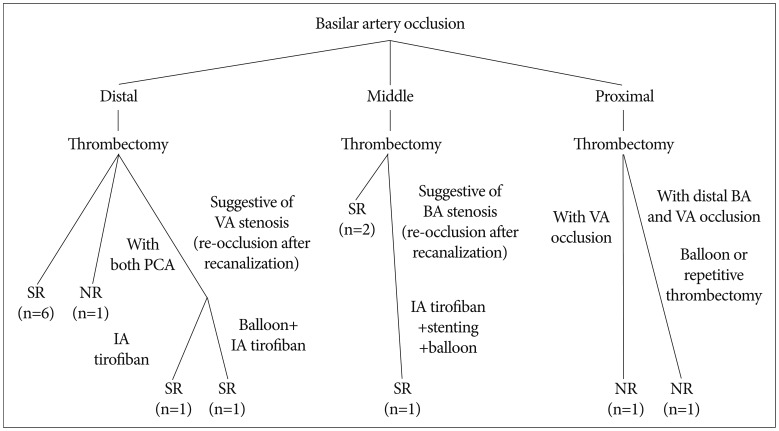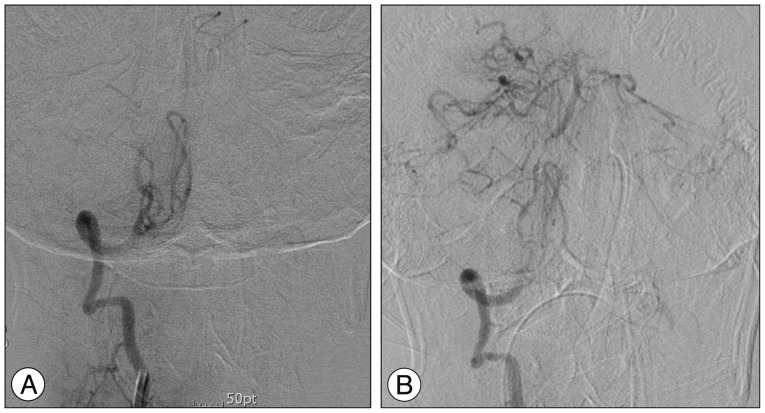J Korean Neurosurg Soc.
2015 Nov;58(5):419-425. 10.3340/jkns.2015.58.5.419.
The Effectiveness of Additional Treatment Modalities after the Failure of Recanalization by Thrombectomy Alone in Acute Vertebrobasilar Arterial Occlusion
- Affiliations
-
- 1Department of Neurosurgery, Keimyung University School of Medicine, Daegu, Korea. ppori2k@naver.com
- 2Department of Neurology, Keimyung University School of Medicine, Daegu, Korea.
- 3Department of Interventional Neuroradiology, Keimyung University School of Medicine, Daegu, Korea.
- KMID: 2191406
- DOI: http://doi.org/10.3340/jkns.2015.58.5.419
Abstract
OBJECTIVE
Acute vertebrobasilar artery occlusion (AVBAO) is a devastating disease with a high mortality rate. One of the most important factors affecting favorable clinical outcome is early recanalization. Mechanical thrombectomy is an emerging treatment strategy for achieving a high recanalization rates. However, thrombectomy alone can be insufficient to complete recanalization, especially for acute stroke involving large artery atheromatous disease. The purpose of this study is to investigate the safety and efficacy of mechanical thrombectomy in AVBAO.
METHODS
Fourteen consecutive patients with AVBAO were treated with mechanical thrombectomy. Additional multimodal treatments were intra-arterial (IA) thrombolysis, balloon angioplasty, or permanent stent placement. Recanalization by thrombectomy alone and multimodal treatments were assessed by the Thrombolysis in Cerebral Infarction (TICI) score. Clinical outcome was determined using the National Institutes of Health Stroke Scale (NIHSS) at 7 days and the modified Rankin Scale (mRS) at 3 months.
RESULTS
Thrombectomy alone and multimodal treatments were performed in 10 patients (71.4%) and 4 patients (28.6%), respectively. Successful recanalization (TICI 2b-3) was achieved in 11 (78.6%). Among these 11 patients, 3 (27.3%) underwent multimodal treatment due to underlying atherosclerotic stenosis. Ten (71.4%) of the 14 showed NIHSS score improvement of >10. Overall mortality was 3 (21.4%) of 14.
CONCLUSION
We suggest that mechanical thrombectomy is safe and effective for improving recanalization rates in AVBAO, with low complication rates. Also, in carefully selected patients after the failure of recanalization by thrombectomy alone, additional multimodal treatment such as IA thrombolysis, balloons, or stents can be needed to achieve successful recanalization.
MeSH Terms
Figure
Reference
-
1. Adams HP Jr, Bendixen BH, Kappelle LJ, Biller J, Love BB, Gordon DL, et al. Classification of subtype of acute ischemic stroke. Definitions for use in a multicenter clinical trial. TOAST. Trial of Org 10172 in Acute Stroke Treatment. Stroke. 1993; 24:35–41. PMID: 7678184.
Article2. Andersson T, Kuntze Söderqvist Å, Söderman M, Holmin S, Wahlgren N, Kaijser M. Mechanical thrombectomy as the primary treatment for acute basilar artery occlusion : experience from 5 years of practice. J Neurointerv Surg. 2013; 5:221–225. PMID: 22434906.
Article3. Archer CR, Horenstein S. Basilar artery occlusion : clinical and radiological correlation. Stroke. 1977; 8:383–390. PMID: 860293.
Article4. Brekenfeld C, Schroth G, Mordasini P, Fischer U, Mono ML, Weck A, et al. Impact of retrievable stents on acute ischemic stroke treatment. AJNR Am J Neuroradiol. 2011; 32:1269–1273. PMID: 21566010.
Article5. Caplan LR, Wityk RJ, Glass TA, Tapia J, Pazdera L, Chang HM, et al. New England Medical Center Posterior Circulation registry. Ann Neurol. 2004; 56:389–398. PMID: 15349866.
Article6. Castaño C, Dorado L, Guerrero C, Millán M, Gomis M, Perez de, et al. Mechanical thrombectomy with the Solitaire AB device in large artery occlusions of the anterior circulation : a pilot study. Stroke. 2010; 41:1836–1840. PMID: 20538693.
Article7. Costalat V, Machi P, Lobotesis K, Maldonado I, Vendrell JF, Riquelme C, et al. Rescue, combined, and stand-alone thrombectomy in the management of large vessel occlusion stroke using the solitaire device : a prospective 50-patient single-center study : timing, safety, and efficacy. Stroke. 2011; 42:1929–1935. PMID: 21597019.
Article8. Eom YI, Hwang YH, Hong JM, Choi JW, Lim YC, Kang DH, et al. Forced arterial suction thrombectomy with the penumbra reperfusion catheter in acute basilar artery occlusion : a retrospective comparison study in 2 Korean university hospitals. AJNR Am J Neuroradiol. 2014; 35:2354–2359. PMID: 25034774.
Article9. Espinosa de Rueda M, Parrilla G, Zamarro J, García-Villalba B, Hernández F, Moreno A. Treatment of acute vertebrobasilar occlusion using thrombectomy with stent retrievers : initial experience with 18 patients. AJNR Am J Neuroradiol. 2013; 34:1044–1048. PMID: 23124642.
Article10. Hacke W, Zeumer H, Ferbert A, Brückmann H, del Zoppo GJ. Intra-arterial thrombolytic therapy improves outcome in patients with acute vertebrobasilar occlusive disease. Stroke. 1988; 19:1216–1222. PMID: 3176080.
Article11. Higashida RT, Furlan AJ, Roberts H, Tomsick T, Connors B, Barr J, et al. Trial design and reporting standards for intra-arterial cerebral thrombolysis for acute ischemic stroke. Stroke. 2003; 34:e109–e137. PMID: 12869717.
Article12. Kase CS, Furlan AJ, Wechsler LR, Higashida RT, Rowley HA, Hart RG, et al. Cerebral hemorrhage after intra-arterial thrombolysis for ischemic stroke : the PROACT II trial. Neurology. 2001; 57:1603–1610. PMID: 11706099.
Article13. Kim HY, Chung CS, Moon SY, Lee KH, Han SH. Complete nonvisualization of basilar artery on MR angiography in patients with vertebrobasilar ischemic stroke : favorable outcome factors. Cerebrovasc Dis. 2004; 18:269–276. PMID: 15331872.
Article14. Lindsberg PJ, Mattle HP. Therapy of basilar artery occlusion : a systematic analysis comparing intra-arterial and intravenous thrombolysis. Stroke. 2006; 37:922–928. PMID: 16439705.15. Lutsep HL, Rymer MM, Nesbit GM. Vertebrobasilar revascularization rates and outcomes in the MERCI and multi-MERCI trials. J Stroke Cerebrovasc Dis. 2008; 17:55–57. PMID: 18346645.
Article16. Miteff F, Faulder KC, Goh AC, Steinfort BS, Sue C, Harrington TJ. Mechanical thrombectomy with a self-expanding retrievable intracranial stent (Solitaire AB) : experience in 26 patients with acute cerebral artery occlusion. AJNR Am J Neuroradiol. 2011; 32:1078–1081. PMID: 21493763.
Article17. Mordasini P, Brekenfeld C, Byrne JV, Fischer U, Arnold M, Heldner MR, et al. Technical feasibility and application of mechanical thrombectomy with the Solitaire FR Revascularization Device in acute basilar artery occlusion. AJNR Am J Neuroradiol. 2013; 34:159–163. PMID: 22723058.
Article18. Mordasini P, Frabetti N, Gralla J, Schroth G, Fischer U, Arnold M, et al. In vivo evaluation of the first dedicated combined flow-restoration and mechanical thrombectomy device in a swine model of acute vessel occlusion. AJNR Am J Neuroradiol. 2011; 32:294–300. PMID: 20966052.
Article19. Mourand I, Machi P, Milhaud D, Picot MC, Lobotesis K, Arquizan C, et al. Mechanical thrombectomy with the Solitaire device in acute basilar artery occlusion. J Neurointerv Surg. 2014; 6:200–204. PMID: 23645572.
Article20. Möhlenbruch M, Stampfl S, Behrens L, Herweh C, Rohde S, Bendszus M, et al. Mechanical thrombectomy with stent retrievers in acute basilar artery occlusion. AJNR Am J Neuroradiol. 2014; 35:959–964. PMID: 24287087.
Article21. Park S, Hwang SM, Song JS, Suh DC, Lee DH. Evaluation of the Solitaire system in a canine arterial thromboembolic occlusion model : is it safe for the endothelium? Interv Neuroradiol. 2013; 19:417–424. PMID: 24355144.
Article22. Pfefferkorn T, Holtmannspötter M, Schmidt C, Bender A, Pfister HW, Straube A, et al. Drip, ship, and retrieve : cooperative recanalization therapy in acute basilar artery occlusion. Stroke. 2010; 41:722–726. PMID: 20150550.23. Pfefferkorn T, Mayer TE, Opherk C, Peters N, Straube A, Pfister HW, et al. Staged escalation therapy in acute basilar artery occlusion : intravenous thrombolysis and on-demand consecutive endovascular mechanical thrombectomy : preliminary experience in 16 patients. Stroke. 2008; 39:1496–1500. PMID: 18323481.
Article24. Roth C, Mielke A, Siekmann R, Ferbert A. First experiences with a new device for mechanical thrombectomy in acute basilar artery occlusion. Cerebrovasc Dis. 2011; 32:28–34. PMID: 21576940.
Article25. Sairanen T, Strbian D, Soinne L, Silvennoinen H, Salonen O, Artto V, et al. Intravenous thrombolysis of basilar artery occlusion : predictors of recanalization and outcome. Stroke. 2011; 42:2175–2179. PMID: 21737807.
Article26. Sarikaya H, Arnold M, Engelter ST, Lyrer PA, Mattle HP, Georgiadis D, et al. Outcomes of intravenous thrombolysis in posterior versus anterior circulation stroke. Stroke. 2011; 42:2498–2502. PMID: 21778443.
Article27. Schulte-Altedorneburg G, Hamann GF, Mull M, Kühne D, Liebetrau M, Weber W, et al. Outcome of acute vertebrobasilar occlusions treated with intra-arterial fibrinolysis in 180 patients. AJNR Am J Neuroradiol. 2006; 27:2042–2047. PMID: 17110663.
- Full Text Links
- Actions
-
Cited
- CITED
-
- Close
- Share
- Similar articles
-
- An Emergency Stenting for Acute Vertebrobasilar Artery Occlusion: Case Report
- Analysis of failed mechanical thrombectomy with a focus on technical reasons: Ten years of experience in a single institution
- Causes and Solutions of Endovascular Treatment Failure
- Critical Use of Balloon Angioplasty after Recanalization Failure with Retrievable Stent in Acute Cerebral Artery Occlusion
- Forced Arterial Suction Thrombectomy Using Distal Access Catheter in Acute Ischemic Stroke



